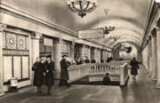
Paveletskaya-Koltsevaya
Encyclopedia



Koltsevaya Line
The Koltsevaya Line , , is a railway line of the Moscow Metro. The line was built in 1950-1954 encircling the central Moscow, and became crucial to the transfer patterns of passengers....
of the Moscow Metro
Moscow Metro
The Moscow Metro is a rapid transit system serving Moscow and the neighbouring town of Krasnogorsk. Opened in 1935 with one line and 13 stations, it was the first underground railway system in the Soviet Union. As of 2011, the Moscow Metro has 182 stations and its route length is . The system is...
. Opened on 1 January 1950 as part of the first segment of the fourth stage, the station is a pylon-trivault
Pylon station
The pylon station is a type of deep underground subway station. The basic distinguishing characteristic of the pylon station is the manner of division of the central hall from the station tunnels...
built in the style of the late 1940/early 1950s Stalinist Architecture
Stalinist architecture
Stalinist architecture , also referred to as Stalinist Gothic, or Socialist Classicism, is a term given to architecture of the Soviet Union between 1933, when Boris Iofan's draft for Palace of the Soviets was officially approved, and 1955, when Nikita Khrushchev condemned "excesses" of the past...
to a design by architects Nikolai Kolli
Nikolai Kolli
Nikolai Dzhemsovich Kolli was a Russian Constructivist architect and city planner.Born in Moscow, Kolli studied at the Moscow School of Painting, Sculpture and Architecture and then at Vkhutemas...
and I.Kasetl. The station's theme comes from the Paveletsky Rail Terminal from which trains depart towards the Volga Region
Volga Region
Volga Region is a historical region of Russia that encompasses the territories adjacent to the flow of Volga River. According to the flow of the river, it is usually classified into the Middle Volga Region and Lower Volga Region...
. Thus agricultural influences are clearly seen, these include the square white koyelga marble columns decorated with red marble strips, flanked by marble columns with modern Ionic capitals
Ionic order
The Ionic order forms one of the three orders or organizational systems of classical architecture, the other two canonic orders being the Doric and the Corinthian...
. Bright bronze chandeliers provide lighting. The walls repeat the two tone marble, white on top, red on bottom, and the floor is laid with grey and white granite.
The station's vestibule is built into the corner of Sadovoye Koltso and Zemlyannoy Val, and occupies the ground floor of the building there. Inside above the escalator is a circular mosaic panel by Pavel Korin
Pavel Korin
Pavel Dmitriyevich Korin was a Russian painter and art restorer. He is famous for his preparational work for the unimplemented painting Farewell to Rus.-Life and career:...
Red Square which depicts the Lenin's Mausoleum
Lenin's Mausoleum
Lenin's Mausoleum also known as Lenin's Tomb, situated in Red Square in the center of Moscow, is the mausoleum that serves as the current resting place of Vladimir Lenin. His embalmed body has been on public display there since shortly after his death in 1924...
and the St Basil's Cathedral, frammed by a bas-relief with typical soviet banners and floral arrangements with names of Volga cities on the sides. The vestibule has another artwork by Iosif Rabinovich, which is a mosaic on the dome of the vestibule on the theme of the permanent end to drought in the Volga.
As the station was made to be a transfer point to Paveletskaya-Radialnaya
Paveletskaya-Radialnaya
Paveletskaya is a Moscow Metro station on the Zamoskvoretskaya Line. It was opened in 1943 and was designed by S.V. Lyashchenko and E.S. Demchenko. Paveletskaya features tall white marble pillars decorated with the hammer and sickle and a high, arched ceiling...
the vestibule was built as an entrance to both stations, however as the radial station of the Zamoskvoretskaya Line
Zamoskvoretskaya Line
Zamoskvoretskaya Line , formerly Gorkovsko-Zamoskvoretskaya , is a line of the Moscow Metro. Opened in 1938, chronologically it became the third line. There are twenty stations on the Zamoskvoretskaya line, and it spans , roughly crossing Moscow in a north-south direction. A normal trip along the...
was undergoing reconstruction the vestibule doubled as a transfer point. A direct corridor was opened only on 30 July 1955, which saw the addition of large staircases surrounded by marble ballustrades in the centre of the platform. The other major change was that initially in the end of the station was a large medallion with image of Vladimir Lenin
Vladimir Lenin
Vladimir Ilyich Lenin was a Russian Marxist revolutionary and communist politician who led the October Revolution of 1917. As leader of the Bolsheviks, he headed the Soviet state during its initial years , as it fought to establish control of Russia in the Russian Civil War and worked to create a...
and Joseph Stalin
Joseph Stalin
Joseph Vissarionovich Stalin was the Premier of the Soviet Union from 6 May 1941 to 5 March 1953. He was among the Bolshevik revolutionaries who brought about the October Revolution and had held the position of first General Secretary of the Communist Party of the Soviet Union's Central Committee...
, but during the 1961 de-Stalinization drive this was removed and instead replaced by the present artwork by Pavel Korin showing the Coat of Arms of the Soviet Union
Coat of arms of the Soviet Union
The State Emblem of the Soviet Union was adopted in 1923 and was used until the dissolution of the Soviet Union in 1991. Although it technically is an emblem rather than a coat of arms, since it does not follow heraldic rules, in Russian it is called герб , the word used for a traditional coat of...
being held by a worker man and peasant woman amid floral backgrounds.

